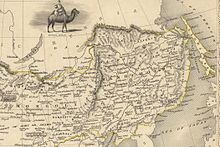
Back تاريخ منشوريا Arabic Маньчжури историйĕ CV Histoire de la Mandchourie French Mandžiūrijos istorija Lithuanian История Маньчжурии Russian மஞ்சூரியாவின் வரலாறு Tamil Lịch sử Mãn Châu Vietnamese 滿洲歷史 Chinese

| History of Manchuria |
|---|
 |
Manchuria is a region in East Asia. Depending on the definition of its extent, Manchuria can refer either to a region falling entirely within present-day China, or to a larger region today divided between Northeast China and the Russian Far East. To differentiate between the two parts following the latter definition, the Russian part is also known as Outer Manchuria (or Russian Manchuria), while the Chinese part is known as Northeast China.
Manchuria is the homeland of the Manchu people. "Manchu" is a name introduced by Hong Taiji of the Qing dynasty in 1636 for the Jurchen people, a Tungusic people.
The population grew from about 1 million in 1750 to 5 million in 1850 and to 14 million in 1900, largely because of the immigration of Han farmers.
Lying at the juncture of the Chinese, Japanese and Russian spheres of influence, Manchuria has been a hotbed of conflict since the late-19th century. The Russian Empire established control over the northern part of Manchuria in 1860 (Beijing Treaty); it built (1897-1902) the Chinese Eastern Railway to consolidate its control. Disputes over Manchuria and Korea led to the Russo-Japanese War of 1904–1905. The Japanese invaded Manchuria in 1931, setting up the puppet state of Manchukuo which became a centerpiece of the fast-growing Empire of Japan. The Soviet invasion of Manchuria in August 1945 led to the rapid collapse of Japanese rule, and the Soviets restored the region of Manchuria to Chinese rule: Manchuria served as a base of operations for the Mao Zedong's People's Liberation Army in the Chinese Civil War, which led to the formation of the People's Republic of China in 1949. In the Korean War of 1950-1953, Chinese forces used Manchuria as a base to assist North Korea against the United Nations Command forces. During the Sino–Soviet split Manchuria became a matter of contention, escalating to the Sino–Soviet border conflict in 1969. The Sino-Russian border dispute was resolved diplomatically only in 2004.
In recent years[when?] scholars have studied 20th-century Manchuria extensively, while paying less attention to the earlier period.[citation needed]
© MMXXIII Rich X Search. We shall prevail. All rights reserved. Rich X Search